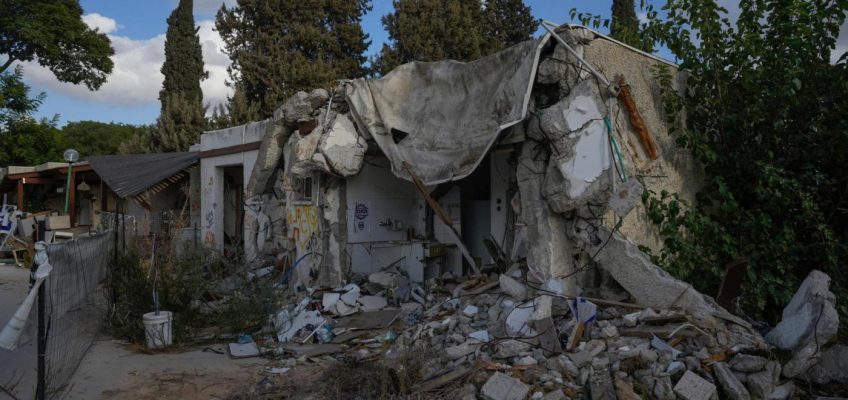By DAN MERICA and BRIAN SLODYSKO
WASHINGTON (AP) — Turning Point’s representatives have made two things clear in meetings with state and local Republican leaders — Donald Trump has blessed their conservative organization to help lead his get-out-the-vote effort, and local party officials ought to use the group’s new voter mobilization app.
Both prospects terrify fellow Republicans.
Soaring to prominence after Trump’s unexpected 2016 win, Turning Point earned a reputation for hosting glitzy events, cultivating hard-right influencers and raising prodigious sums of money while enriching the group’s leaders. They’ve had far less success helping Republicans win, especially in their adopted home state of Arizona.
Now the organization has leveraged its ties to Trump to expand its influence in a way that could be potentially lucrative. Turning Point has sought to lead an effort to remake the GOP’s get-out-the-vote effort based on the theory that there are thousands of Trump supporters who rarely vote but could be persuaded to in this year’s election. And they are pitching their new mobile app as vital to this effort’s success.
The Associated Press obtained an unvarnished look at how Turning Point is promoting its strategy by obtaining several recordings of presentations made by its representatives to state and local Republican officials. In those presentations, Turning Point operatives honed in on churchgoers and hunters, citing statistics that purport to show how few of each group cast ballots in 2020. Their argument, which is questioned by critics, is if groups like Turning Point target such groups, Republicans will likely sweep the swing states for Trump, the recordings show.
FILE – Republican presidential candidate former President Donald Trump gestures as he finishes speaking at The Believers’ Summit 2024 at a Turning Point Action event in West Palm Beach, Fla., July 26, 2024. (AP Photo/Lynne Sladky, File)
The decision by Trump to rely on untested groups such as Turning Point could have sweeping implications for November’s election. Turning Point says it’s operating statewide in Arizona and Wisconsin, two must win states for Trump. It’s also working in two competitive House districts, one in Michigan and another in Nevada, that could also help tip the balance in the presidential race.
The difference of just a few thousand votes in battleground states could mean victory or defeat for candidates up and down the ballot. It’s also a risky move that dismisses independent voters, a small but significant portion of the electorate.
“Their strategy is bad. They know how to talk MAGA, they know how to message the base,” said Tyler Montague, a Republican strategist from Arizona and a longtime Turning Point critic, referring to the former president’s Make America Great Again movement. “But they literally don’t know what to say to a swing voter. They alienate these people.”
A Turning Point spokesman rebuffed such criticism, saying the group is performing an important role for conservative candidates. “We did this because we knew conservatives need” a way to identify and turn out voters, said spokesman Andrew Kolvet. He added that the effort reflects lessons Turning Point has learned from defeats Republicans suffered in Arizona in 2022 and elsewhere and how Democrats have embraced similar tactics.
From influencers to organizers
Turning Point was founded in suburban Chicago over a decade ago by Charlie Kirk, then a recent high school graduate, to nurture the next generation of conservatives. But as its leaders age out of the youth movement, the group’s brand of far-right politics hasn’t been very persuasive to Arizona’s general election voters, who rejected conservative candidates for statewide office in 2022, including gubernatorial nominee Kari Lake.
Turning Point’s leaders showed a degree of introspection after those losses. Not only had they failed to mobilize GOP voters, but Kirk had also amplified Trump’s false claims that voting by mail was rife with fraud, putting Republicans at a strategic disadvantage by discouraging a convenient way to cast a ballot.
They reversed course for the 2024 election and launched a campaign to raise $108 million for a “ballot chasing” operation that would expand beyond Arizona to key presidential swing states, where they are canvasing reliably Republican areas and encouraging low-turnout voters to cast a ballot by mail. Kolvet, Turning Point’s spokesman, said they have so far raised tens of millions of dollars as part of this effort.
Turning Point’s get-out-the-vote work is part of a broader effort to elect Trump that includes 30,000 volunteers recruited by the former president’s campaign, as well as work being done by such outside groups as Elon Musk’s America PAC, which has paid at least $45 million to voter canvasing firms this year.
Musk’s PAC took over as the leader of voter mobilization efforts in Wisconsin, a position that Turning Point had previously held. Turning Point will now play a secondary role in the state, while directing much of their focus to Arizona, a development previously reported by Politico.
A straightforward, if questionable, strategy
The group’s strategy isn’t complicated: Its operatives believe there is a well of untapped conservative voters who have not backed Trump in recent elections. To get Trump back to the White House, they believe the best path is to activate those voters. The strategy appears to mostly ignore independents — or less hardened Republicans — because Turning Point’s brand of hard-right politics is less likely to appeal to them.
In the recordings obtained by the AP, Turning Point’s representatives fully embraced that strategy and believe it would have helped them win past elections and ensure victory in November.
“If we just have an ounce of ballot chasing, just in Arizona,” Republicans would have won all their races, Matthew Martinez, a Turning Point official, said at a June event in Detroit, referring to the practice of convincing people to vote early while reaching out to those who haven’t cast ballots
Martinez added that Republicans faced the same challenges in Michigan, Wisconsin and Georgia. In all three states, Martinez said, “Republicans are sincerely disengaged.”
Kirk wrote this month that Turning Point had assigned a full-time staffer or volunteer to chase every low-propensity voter on their target list in Arizona.
Experts in voting patterns are doubtful Turning Point’s efforts to mobilize infrequent Trump-inclined voters will do much to affect the election. Turnout in the past two presidential elections has already drawn a record number of voters to the polls, the experts noted, meaning the pool of voters they are seeking to turn out is small and particularly unlikely to vote.
“You had the highest turnout in Michigan in those presidential election years than you’ve ever had before. It’s doubtful they’re going to get any more,” said Bernie Porn, a nonpartisan pollster who’s worked in the state for more than 30 years.
‘Just download the app’
For over a year, Turning Point has aggressively pitched its new voter mobilization app — a potentially lucrative venture that, if successful, critics believe could strengthen its grasp on key Republican Party machinery. In meetings with state and local Republican leaders, Turning Point operatives lean heavily into their close affiliation with Trump, who is a regular speaker at Turning Point conferences, according to the recordings obtained by theAP.
“We now are an official arm of the Trump campaign,” Turning Point operative Luke Malace told the members of the Monroe County Republican Party in Michigan earlier this year while urging the group to become a paying “client” of the company that made the Turning Point app.
Martinez, at the June event, told attendees concerned about helping Republicans win that the best way to help was to use the app.
Related Articles
Harris talks abortion and more on ‘Call Her Daddy’ podcast as Democratic ticket steps up interviews
Tips, overtime, Social Security: A look at Donald Trump’s no-tax pledges and what they might cost
Turf war? Florida in apparent clash with feds over Trump golf gunman investigation
New analysis suggests national debt could increase under Harris, but it would surge under Trump
Changing demographics and the political calculus of anti-immigrant rhetoric in swing states
“Sir, just download the app – and everybody in here, too, download the app,” said Martinez, a Turning Point official.
The app was designed by Superfeed, a company with direct ties to Turning Point’s leaders. Tyler Bowyer, Turning Point’s chief operating officer, sits on the company’s board and was formerly the company’s chairman, business filings show. Kirk’s mother-in-law also serves on Superfeed’s board.
It’s unclear how much the company has made from apps it designed for Turning Point and over a dozen other GOP and conservative groups, including state parties in Arizona, Nevada and Delaware. Recent state and federal campaign finance disclosures do not show any payments to Superfeed.
In private, a Turning Point representative did not seek to disguise the connection between the app and their group.
“It’s all in-house,” Malace told the county party in Michigan.
Malace did not respond to a request for comment. Superfeed officials also did not respond to a request for comment.
Kolvet, the Turning Point spokesman, said that Malace mischaracterized the organization’s relationship with the app maker. Turning Point does not receive any money earned by Superfeed, and the conservative group isn’t “financially involved” with the app maker, Kolvet said.
“Our relationship with Superfeed is we are a client and they are a vendor,” Kolvet said.
The app and Turning Point’s data plans draw criticism
Some Republicans told the AP that there are major issues with Turning Point’s app, which has minimal protections to secure voters’ personal information.
The platform allows anyone who uses it, including an AP reporter, to quickly gain access to detailed personal information, including voters’ full names, addresses, ages and cellphone numbers. That’s a departure from the security protocols adopted by other such platforms. Such protocols are designed to safeguard personal information and prevent rival parties from stealing data or spying on a campaign’s strategy.
But not everyone is critical of the app.
Matt Brown, chair of the Yakima County Republican Party in Washington, said he learned about the app during a talk at a Turning Point conference in December. Brown was wowed and decided to become a Superfeed client, and began using the app a few months ago. He declined to say how much the party pays Superfeed, but praised Turning Point’s new focus.
“They are doing the work that no one else wants to do and the party is not doing it,” Brown said of the group.
The app is seen by Republican strategists as the latest example of Turning Point becoming more focused on using data as a way to strengthen its Republican role in the future. And those strategists are concerned that Turning Point is not playing by established traditions of sharing data within the Republican ecosystem and is unprepared to do the kind of work needed to elect Republicans in swing states.
“We have had good ground games in the past, really good ground games. And they were run by the RNC,” said Ron Kaufman, a longtime Republican who is so closely associated with the Republican National Committee he has been referred to as “Mr. RNC” in the past. “It doesn’t make sense to turn that operation over to an outside organization that doesn’t have the institutional knowledge that the committee has.”
Turning Point, for example, is not sharing its voter data with Data Trust, a Republican information clearinghouse that allows GOP campaigns and groups to use data collected by groups throughout the party’s ecosystem. Other Republican operatives said Turning Point is not sharing data with key statewide campaigns in the battlegrounds they are prioritizing.
Such data is the “lifeblood” of modern electioneering, said Montague, the Arizona Republican who has been critical of Turning Point.
He said the group’s foray into providing other groups data is further evidence it is attempting “to take over the party at the national level.”
Turning Point’s spokesman denied the charge, saying the group was not seeking to take over the GOP and blaming their lack of sharing with the Data Trust on not having access when they started this work.
“It’s just craziness,” Kolvet said. “We don’t want the job.”




